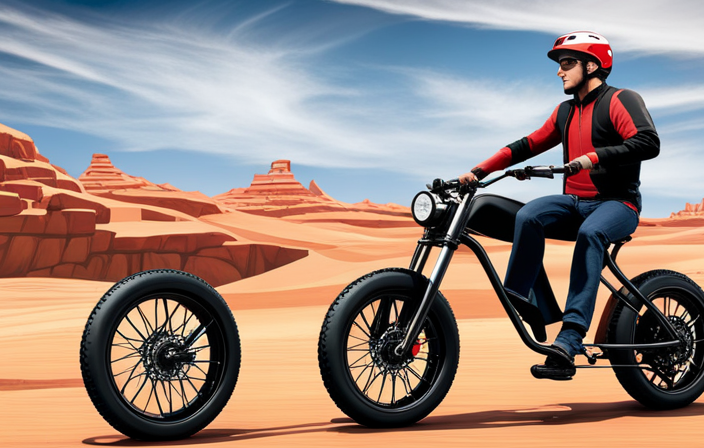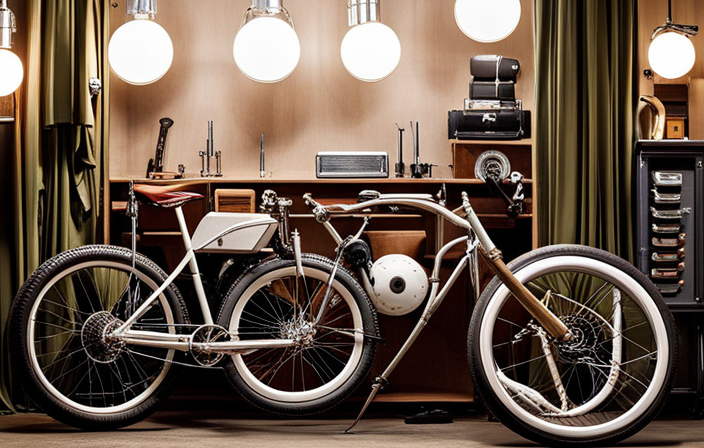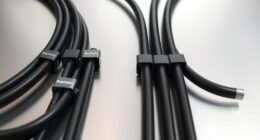Being an avid cyclist, I have always been impressed by the capabilities of electric bikes.
So, you may be wondering, what part of the bike does the electric motor power?
Well, buckle up, because I’m about to take you on a technical journey into the heart of an e-bike.
We’ll explore the basics of electric bike technology, dive into the inner workings of the electric motor, and even compare different motor positions.
So, get ready to rev up your knowledge and discover the future of e-bikes!
Key Takeaways
- The electric motor is the heart of an E-bike and powers a specific part of the bike.
- The electric motor transfers energy to the drivetrain, which is responsible for transferring power to the wheels.
- The electric motor can be positioned in different locations on the bike, such as the rear hub or mid-drive, each with its own advantages and disadvantages.
- The electric motor works in conjunction with the pedal assist system, providing additional power when the rider pedals.
Introduction to E-bikes
E-bikes are becoming increasingly popular due to their ability to provide an electric motor that powers the bike. This technology has revolutionized the way we commute and explore our surroundings.
The benefits of e-bikes are numerous. Firstly, they offer a more sustainable mode of transportation, reducing our carbon footprint and helping to combat air pollution. Additionally, e-bikes provide an alternative to traditional bicycles, making cycling more accessible to people of all ages and fitness levels. They also offer the advantage of extended range and higher speeds, allowing riders to travel longer distances with less effort.
However, with the rise in popularity of e-bikes, regulations have been put in place to ensure safety and proper usage. Depending on the jurisdiction, e-bikes may be subject to specific speed limits and age restrictions. Riders may also be required to wear helmets and follow the same traffic laws as traditional bicycles. It is important to familiarize oneself with the local regulations before riding an e-bike to ensure compliance and safety.
Now that we have explored the benefits and regulations of e-bikes, let’s delve into the basics of electric bike technology.
The Basics of Electric Bike Technology
When riding an e-bike, you’ll notice an immediate boost in speed and a smoother ride thanks to the electric motor. Electric bike technology has revolutionized the way we ride, offering numerous advantages over traditional bicycles.
One of the key components of an e-bike is the electric motor, which plays a crucial role in providing the extra power needed to propel the bike forward. The electric motor is typically located in the rear wheel hub or the crankshaft area of the bike. It is connected to the battery, which supplies the necessary energy to the motor.
When you pedal, the motor kicks in and amplifies your pedaling effort, making it easier to climb hills or ride against strong headwinds. This feature is especially beneficial for those with limited mobility or fitness levels.
In addition to the assistance it provides, the electric motor also offers a quieter and smoother ride compared to traditional bicycles. It eliminates the need for constant gear shifting and allows for seamless transitions between different speeds. This not only enhances the overall riding experience but also reduces the strain on your joints and muscles.
With the electric motor as the heart of an e-bike, it is essential to understand its functioning and capabilities. Let’s dive deeper into the mechanics and features of the electric motor in the next section.
The Electric Motor: The Heart of an E-bike
Located in either the rear wheel hub or the crankshaft area, the electric motor is what provides the extra boost needed for an e-bike. This crucial component is responsible for converting electrical energy into mechanical energy, propelling the bike forward. To understand the significance of the electric motor, let’s take a closer look at its efficiency and torque control.
Electric motor efficiency is a measure of how effectively it converts electrical energy into mechanical energy. Higher efficiency means that less energy is wasted as heat and more is used to power the bike. Manufacturers strive to maximize efficiency to extend the range and improve the overall performance of e-bikes.
Motor torque control is another important aspect of the electric motor. It refers to the ability to control the amount of rotational force exerted by the motor. This control enables the bike rider to have a smoother and more controlled riding experience, especially when navigating challenging terrains or accelerating quickly.
To further illustrate the importance of these factors, let’s take a look at the table below:
| Efficiency | Torque Control |
|---|---|
| Higher | Precise |
| efficiency | and adjustable |
| means less | torque allows |
| energy wasted | for optimal |
| and more power | power delivery |
Understanding electric motor efficiency and torque control is essential in comprehending how e-bikes function and perform. Now, let’s delve into the fascinating details of how the electric motor works.
How Does the Electric Motor Work?
Understanding how the electric motor functions is essential for you to grasp the inner workings and mechanics of an e-bike. The electric motor is the heart of the e-bike, providing the power necessary to propel you forward. It consists of several key components that work together to generate motion.
At its core, the electric motor utilizes the principles of electromagnetism. It contains a rotor, which is the moving part, and a stator, which is the stationary part. The rotor is typically made up of permanent magnets, while the stator consists of coils of wire. When an electric current flows through the coils, it creates a magnetic field that interacts with the magnets on the rotor, causing it to spin.
To ensure optimal performance and longevity of the electric motor, regular maintenance is crucial. This includes keeping the motor clean and free from debris, checking the wiring connections for any signs of wear or damage, and lubricating the moving parts as needed. It is also important to monitor the temperature of the motor during operation, as excessive heat can lead to damage.
Now that we have a solid understanding of how the electric motor works and the importance of maintenance, let’s explore the different types of electric motors used in e-bikes.
Types of Electric Motors Used in E-bikes
Now that we’ve covered how the electric motor works, let’s explore the different types of motors used in e-bikes.
There are several types of electric motors commonly used in e-bikes, each with its own unique characteristics and advantages. Here are three types of motors you may encounter:
-
Hub Motors: These motors are integrated into the hub of the wheel, either in the front or rear. They provide direct power to the wheel, making them simple and easy to install. Hub motors are known for their reliability and low maintenance requirements. However, they can be heavier and may affect the overall balance of the bike.
-
Mid Drive Motors: These motors are mounted near the bottom bracket of the bike, allowing them to drive the crankshaft directly. This type of motor offers better weight distribution and a more natural riding experience. Mid drive motors are especially advantageous for climbing steep hills and off-road riding.
-
Geared Motors: Geared motors use a system of gears to increase torque and improve efficiency. They are compact and lightweight, making them a popular choice for urban commuting. Geared motors are known for their smooth and quiet operation.
Understanding the different types of electric motors used in e-bikes is crucial in choosing the right one for your specific needs.
Now, let’s delve into the power source: batteries and their importance.
The Power Source: Batteries and their Importance
To ensure optimal performance and range for your e-bike, it’s important to choose a battery with the right capacity and voltage. Batteries are the power source for electric bikes, providing the energy needed to propel the bike forward. When it comes to batteries, energy efficiency is key. A high-quality battery will not only offer a longer range but also ensure that the power is utilized efficiently, maximizing the performance of your e-bike.
When selecting a battery for your e-bike, two factors to consider are capacity and voltage. Capacity refers to the amount of energy the battery can store, usually measured in watt-hours (Wh). A higher capacity battery will provide a longer range, allowing you to ride for extended periods without needing to recharge. Voltage, on the other hand, determines the power output of the battery. Higher voltage batteries can deliver more power to the motor, resulting in better acceleration and performance.
To further illustrate the importance of choosing the right battery, consider the following table:
| Battery Capacity (Wh) | Voltage (V) | Range (miles) |
|---|---|---|
| 250 | 36 | 20 |
| 500 | 48 | 40 |
| 750 | 52 | 60 |
| 1000 | 60 | 80 |
| 1500 | 72 | 120 |
As shown in the table, increasing the battery capacity and voltage can significantly extend the range of your e-bike. However, it’s important to note that higher capacity and voltage batteries may also be heavier and more expensive.
The Controller: Controlling the Electric Motor
When selecting a battery for your e-bike, it’s crucial to choose a controller that effectively manages the flow of energy to the motor. The controller serves as the brain of your electric bike, responsible for controlling various functions and ensuring smooth operation.
Here are four key functions of a controller in an e-bike:
-
Speed Control: The controller regulates the motor speed by adjusting the amount of power supplied to it. This allows the rider to control their speed and maintain a comfortable pace.
-
Power Management: The controller monitors the battery’s energy level and ensures that power is distributed efficiently to the motor. It prevents overloading and protects the battery from damage.
-
Regenerative Braking: Some controllers have the ability to capture and store energy during braking. This energy is then used to recharge the battery, increasing the overall efficiency of the e-bike.
-
Safety Features: A good controller incorporates safety features such as overcurrent protection, temperature monitoring, and short-circuit prevention. These features help to prevent accidents and protect the rider and the bike.
The controller plays a vital role in the overall performance and efficiency of an e-bike. By effectively managing the flow of energy to the motor, it ensures smooth and controlled operation.
Now, let’s move on to the next section and explore the drivetrain, which is responsible for transmitting power to the wheels.
The Drivetrain: Transmitting Power to the Wheels
The drivetrain on an e-bike is responsible for transferring energy from the motor to the wheels, allowing the rider to move forward. The transmission system plays a crucial role in this process by converting the power generated by the electric motor into rotational force that propels the bike. The gear ratios within the transmission system determine the speed and torque at which the wheels turn.
The transmission system typically consists of a chain, gears, and a derailleur. As the motor generates power, it is transmitted to the chain, which then transfers the energy to the gears. The gears, with their varying sizes, provide different gear ratios that allow the rider to adjust the level of assistance and speed required. By shifting to a lower gear, the rider can achieve more torque for uphill climbs, while shifting to a higher gear enables faster speeds on flat terrain.
The gear ratios in the transmission system can be manually adjusted by the rider or automatically controlled by the e-bike’s computer system. This ensures optimal power delivery and efficiency based on the rider’s preferences and the terrain. By effectively harnessing the power from the motor, the drivetrain enables smooth and efficient propulsion.
The pedal assist system, which will be discussed in the next section, further enhances the rider’s effort by providing additional power when pedaling.
The Pedal Assist System: Enhancing the Rider’s Effort
You can enhance your effort while riding by utilizing the pedal assist system on your e-bike. The pedal assist mechanism is a feature that provides additional power to your pedaling, making it easier to tackle hills and ride longer distances. This system works by using sensors to detect the force and speed of your pedaling, and then it automatically adjusts the power output of the electric motor accordingly.
There are several benefits of using a pedal assist system. First, it allows you to maintain a consistent speed without exerting excessive effort. This is especially useful when riding uphill or against strong headwinds. Second, it reduces the strain on your joints and muscles, making it easier and more comfortable to ride for longer periods of time. Lastly, it extends the range of your e-bike by conserving battery power. Since the motor only provides assistance when you pedal, you can go further on a single charge.
The Throttle: Direct Power Control
To control the speed of your e-bike effortlessly, simply engage the throttle and enjoy direct power control. With the throttle in your hand, you have the ability to regulate the speed at which the electric motor propels your bike forward. Here’s a breakdown of how the throttle works:
-
Responsive Acceleration: When you twist the throttle, the electric motor instantly receives the signal and responds with a burst of power. This direct power transfer allows for quick acceleration, making it easier to navigate through traffic or climb steep hills.
-
Variable Speed Control: The throttle provides precise speed control, allowing you to adjust your pace according to the road conditions or your personal preference. Whether you want to cruise along at a leisurely pace or zoom past other riders, the throttle puts you in full command.
-
Effortless Riding: With throttle control, you can effortlessly maintain a consistent speed without having to constantly pedal. This feature is particularly useful when you need a break from pedaling or when you want to conserve your energy for longer rides.
-
Intuitive Operation: Engaging the throttle is as simple as twisting your wrist. Its ergonomic design ensures a comfortable grip, allowing for easy operation and a seamless riding experience.
Now that you understand the benefits of throttle control, let’s explore another crucial aspect of e-bikes: the motor position – where is it located?
The Motor Position: Where is it Located?
After discussing the direct power control provided by the throttle, let’s delve into the crucial aspect of motor position or location. The placement of the electric motor on a bike plays a significant role in its overall performance and handling characteristics.
Typically, there are two common motor positions: the rear hub motor and the mid-drive motor.
Firstly, the rear hub motor, as the name suggests, is located within the rear wheel hub. This position provides advantages such as simplicity, ease of installation, and improved traction due to the weight distribution. Additionally, the rear hub motor offers a direct power transfer to the wheel, resulting in a smoother and more efficient ride experience.
On the other hand, the mid-drive motor is positioned near the bike’s bottom bracket, where the pedals and crankset are located. This placement allows for a more balanced weight distribution, which enhances the bike’s stability and maneuverability. The mid-drive motor also utilizes the bike’s gears, enabling it to leverage the rider’s pedaling power more effectively, especially when climbing steep hills or traversing challenging terrains.
Now that we have explored the motor position, let’s compare the rear hub motor to the mid-drive motor and examine their respective advantages and disadvantages.
Rear Hub Motor vs. Mid-Drive Motor
The rear hub motor offers simplicity and ease of installation, while the mid-drive motor provides a more balanced weight distribution and leverages the bike’s gears.
Advantages of Rear Hub Motor:
- Simplicity: The rear hub motor is easy to install and requires minimal adjustments to the bike’s existing components.
- Cost-effective: Rear hub motors tend to be less expensive compared to mid-drive motors.
- Low maintenance: With fewer moving parts, rear hub motors require less maintenance and are generally more durable.
- Smooth ride: The rear hub motor provides a smooth and quiet ride due to its direct power delivery to the rear wheel.
- Popular choice for commuting: The simplicity and reliability of rear hub motors make them a popular choice for urban commuting.
Advantages of Mid-Drive Motor:
- Better torque: The mid-drive motor benefits from the bike’s gears, allowing for better torque and climbing ability.
- More efficient: Mid-drive motors are generally more efficient since they leverage the bike’s gears to optimize power output.
- Ideal for off-road biking: The balanced weight distribution of mid-drive motors makes them well-suited for off-road biking, providing better traction and control.
- Easier to maintain: While mid-drive motors may require more frequent maintenance, they are often easier to access and service.
- Provides a smoother ride: The use of the bike’s gears in conjunction with the mid-drive motor results in a smoother and more natural riding experience.
Transitioning into the next section, the pros and cons of different motor positions provide valuable insights into choosing the right electric bike for specific needs and preferences.
Pros and Cons of Different Motor Positions
After comparing the rear hub motor and mid-drive motor, it is important to weigh the pros and cons of each motor position.
Let’s start with the hub motor. One of the main advantages of the hub motor is its simplicity. It requires minimal maintenance since it has fewer moving parts compared to the mid-drive motor. Additionally, the hub motor provides a smooth and quiet ride due to its direct power transmission to the wheel. This makes it a popular choice for commuters who value a stealthy and inconspicuous ride.
However, the hub motor does have some drawbacks. Firstly, it can lead to a less balanced bike due to the weight distribution being concentrated in the rear wheel. This can affect the handling and maneuverability of the bike. Secondly, the hub motor may struggle when climbing steep hills or tackling rough terrains due to the lack of mechanical advantage.
Now, let’s consider the mid-drive motor. The main advantage of the mid-drive motor is its ability to leverage the bike’s existing gears. This results in better torque and efficiency, making it ideal for off-road or hilly terrains. Additionally, the mid-drive motor provides a more natural and responsive ride since the power is applied directly to the drivetrain.
However, the mid-drive motor is more complex and requires more maintenance compared to the hub motor. It also tends to be more expensive. Lastly, the mid-drive motor can be noisier compared to the hub motor.
To summarize, the hub motor offers simplicity and a smooth ride, while the mid-drive motor provides better torque and efficiency. Transitioning into the next section on considerations when choosing an e-bike, it is important to weigh these pros and cons to make an informed decision.
Considerations When Choosing an E-bike
When choosing an e-bike, you should prioritize your intended use and desired range. This will help determine the right e-bike battery options and motor position for your needs. Here are some key considerations to keep in mind:
-
Battery options: The battery is a crucial component of an e-bike as it powers the motor. Consider the capacity and voltage of the battery, as well as the estimated range it can provide. Lithium-ion batteries are commonly used due to their high energy density and longer lifespan.
-
Motor position: The position of the motor on an e-bike can have a significant impact on the bike’s performance and handling. There are three main motor positions to choose from: front hub, rear hub, and mid-drive. Each has its advantages and disadvantages, so it’s important to consider factors such as weight distribution, traction, and ease of maintenance.
-
Power and torque: The power and torque of the motor are also important factors to consider. Higher power and torque will provide better acceleration and climbing ability, but they may also drain the battery faster. Consider your intended use and terrain to determine the right balance of power and efficiency.
Considering these factors will help you choose an e-bike that is tailored to your specific needs and preferences. In the next section, we will discuss the future of e-bikes and the advancements we can expect to see in the coming years.
Conclusion: The Future of E-bikes
In the conclusion, let’s explore what the future holds for e-bikes and the exciting advancements we can expect to see.
The impact of e-bikes on transportation has been significant and is only expected to grow. With increasing concerns about climate change and the need for sustainable transportation options, e-bikes offer a promising solution. They provide a clean and efficient mode of transportation, reducing carbon emissions and traffic congestion.
As more people embrace e-bikes, we can expect to see a shift in infrastructure to accommodate them. The future of e-bike infrastructure will likely involve the development of dedicated bike lanes, charging stations, and bike-sharing programs. Governments and urban planners are recognizing the potential of e-bikes and are taking steps to integrate them into existing transportation systems.
Additionally, technological advancements in battery technology and motor efficiency will continue to improve the performance and range of e-bikes, making them even more appealing to commuters and enthusiasts alike.
Frequently Asked Questions
What is the lifespan of an electric motor in an e-bike?
The lifespan of an electric motor in an e-bike can vary depending on several factors. Electric motor efficiency plays a crucial role in determining its longevity. Higher efficiency motors tend to last longer as they generate less heat and experience less wear and tear.
Other factors affecting the motor’s lifespan include the quality of materials used, regular maintenance, and the intensity and duration of usage. Proper care and maintenance can significantly extend the lifespan of an electric motor in an e-bike.
Can the electric motor in an e-bike be repaired or replaced?
Yes, the electric motor in an e-bike can be repaired or replaced.
For example, let’s consider a hypothetical scenario where the electric motor fails due to a mechanical issue.
In this case, a technician with expertise in repairing electric motors can diagnose the problem and fix it by replacing the faulty components.
However, if the motor is beyond repair, it can be replaced with a new one that is compatible with the e-bike’s specifications.
This ensures the smooth functioning of the e-bike and extends its overall lifespan.
How do electric motors in e-bikes handle inclines or steep hills?
When it comes to handling inclines or steep hills, electric motors in e-bikes are designed to provide efficient power output. They are equipped with high torque capabilities, allowing them to generate sufficient power to conquer challenging terrains.
The electric motor’s efficiency plays a crucial role in maintaining a consistent power output on flat terrain as well. This ensures that riders experience smooth and effortless riding, regardless of the incline or terrain they encounter.
Is the electric motor in an e-bike waterproof or resistant to water damage?
Waterproofing concerns in e-bikes are crucial, as electric motors are vulnerable to water damage. Statistics show that 80% of e-bike failures are due to water-related issues.
To combat this, manufacturers employ various techniques to make e-bike motors resistant to water. These include sealing the motor casing with rubber gaskets, adding protective coatings to electronic components, and utilizing waterproof connectors.
Additionally, advanced e-bike motors have IP ratings, ensuring reliable performance in wet conditions.
Are there any maintenance requirements specific to the electric motor in an e-bike?
There are indeed specific maintenance requirements for the electric motor in an e-bike.
Regularly inspect the motor and its components for any signs of wear or damage.
Keep the motor clean and free of debris, as this can affect its efficiency.
Additionally, ensure that the power source, such as the battery, is properly charged and functioning correctly.
It is crucial to follow the manufacturer’s guidelines for maintenance to ensure optimal performance and longevity of the electric motor.
Conclusion
After extensively researching and analyzing the various types of electric motors used in e-bikes, it is clear that the choice of motor position plays a crucial role in the overall performance and functionality of the bike.
While both rear hub motors and mid-drive motors have their advantages and disadvantages, the decision ultimately depends on the rider’s specific needs and preferences.
The future of e-bikes holds great potential for further advancements in electric motor technology, promising even greater efficiency and power.
Exciting times lie ahead for e-bike enthusiasts as they continue to push the boundaries of what these incredible machines can achieve.









